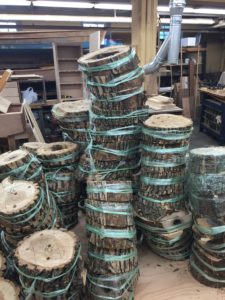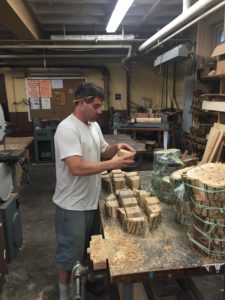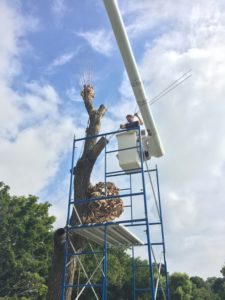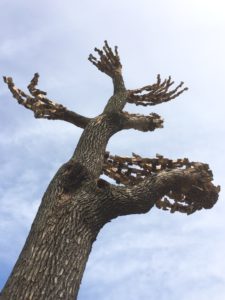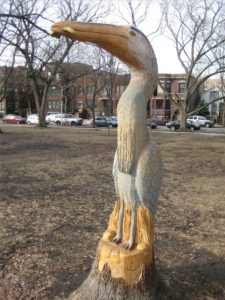The Chicago Tree Project: Transforming Trees in Chicago's Parks
Artist Anthony Heinz May is covered in sawdust in the basement wood shop at the Lincoln Park Cultural Center. He’s spent the last several days methodically cutting branches from a Jackson Park tree into disks that are then further separated into hundreds of small cubes. After drilling holes into each of these cubes, May will take them back to Jackson Park where the tree will be reassembled piece by piece into a pixelated, exploding version of its former self.
"My appropriations of tree refuse identify as physically pixelated forms reflecting relationships between nature, humans, and technology," says Heinz May. "These sculptures appear as fragmented puzzles that are cubed and rearranged in space."
The arms of the tree twist and wrap around the trunk and then shoot out, dancing and dissolving against the blue sky. This is the Chicago Tree Project.
Each year, the Chicago Park District in partnership with Chicago Sculpture International, puts out a call to artists from Chicago and beyond to transform sick and dying Park District trees into vibrant public art.
Using art as a vessel for public engagement, sculptors make over a variety of trees into fun and whimsical experiences for communities throughout the city. Since the project began in 2014, artists have carved, painted, sculpted, and adorned dozens of trees that would have otherwise been cut down.
“The Pilsen residents passing by frequently asked if I was carving suns or ‘soles.’ Some people told stories of how important sun imagery was to Mexican culture. In Mexican culture and throughout our planet, the sun symbolizes life and flourishing nature, life cycles, and positive energy. I observed and felt all of this in the dynamic Pilsen neighborhood and thus decided to change the title of the sculpture to ‘Solspirals.’”
Anne Kamilla Alexander's Solspirals at Harrison Park
Jim Long's Ol' Blue (Heron at Nichols Park
“I derive inspiration from the shape of the tree to be carved. It does not take long before I see what ‘lives’ inside. All that remains is the removal of excess material.”
“People walk past natural elements every day without noticing them. With my sculpture, I try to bring attention to natural life forms, challenging the viewer’s beliefs on nature. My sculpture allows viewers to consider what they know about nature. Hopefully they will also learn to value the natural elements they see every day at Portage Park and the rest of Chicago.”
Vivian Visser's Hive at Portage Park
Check out the Chicago Tree Project Website for images and info about more trees and a map with tree locations!
Interested in making your mark on the Park District public art landscape? Submit a proposal for the 2017 Chicago Tree Project today! Applications open through March 1st.
Emerald Ash Borer tree pattern
You may be wondering, why are there so many dead and dying trees in Chicago’s parks? The largest killer of Park District trees are an invasive beetle called the Emerald Ash Borer. The Emerald Ash Borer gets its name from its emerald color and its taste for Ash trees. The beetles’ larvae get under the bark of trees and eat and infect them, creating intricate patterns while they do so.
The Chicago Park District has been working hard to cut down dead Ash trees and plant new trees in their place. But, rather than cutting them all down, some are saved so they can live a new life as public art!

